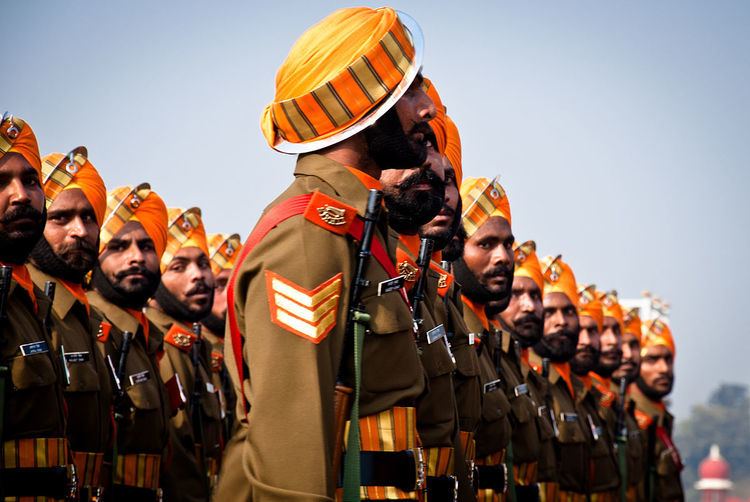Active June 1857-Present Branch Army Size 18 battalions | Country India | |
 | ||
Role PrimaryInfantryAdditional rolesDirect ActionAmphibious warfareMountain warfareCounter TerrorismInternal Security | ||
The Sikh Light Infantry, previously known as The Mazabhi and Ramdasia Sikh Regiment, is a light infantry regiment of the Indian Army. Its name was changed to the Sikh Light Infantry in 1944. The Sikh Light Infantry is the successor unit to the Mazhabi Sikh Pioneers 23rd, 32nd and 34th Sikh Pioneers. The Sikh Light Infantry inherited the battle honours, colours and traditions of the Mazhabi Sikh Pioneers on its merging with a few Ramdasia companies in 1941.
Contents
The Sikh Light Infantry recruits Mazhabi Sikh and Ramdasia soldiers who are famous for their extraordinary courage and tenacity on the battlefield. During its existence for nearly a century under the British Raj, the Sikh Light Infantry and its predecessors, the 23rd, 32nd and 34th Royal Sikh Pioneers distinguished themselves with loyalty to the British Crown and the empire in numerous conflicts in and around the Indian subcontinent as well as the First World War and the Second World War. Today, the Sikh Light Infantry has expanded beyond its primary infantry role and holds an "elite" regimental status. The 9th battalion of the Sikh Light Infantry conducts special amphibious assaults similar in nature to the Royal Marines of the United Kingdom. The 11th battalion of the Sikh Light Infantry has earned the nickname "Steel Fist". The versatility of the Sikh Light Infantry has seen the regiment conduct operations from conventional warfare on the Siachen Glacier, the highest battlefield in the world, to counter-terrorism. The Sikh Light Infantry also conducts operations as part of the United Nations Emergency Force. The regimental motto is "Deg Tegh Fateh", meaning "prosperity in peace and victory in war". The motto has great significance with the tenth and most martial Sikh guru, Guru Gobind Singh], as the Mazhabis are very closely associated with him. The Sikh Light Infantry insignia is a Chakram or Quoit, with a mounted Kirpan. The insignia was designed to honour the Mazhabi Sikh community's Akali Nihang ancestry. The former Chief of Army Staff, General Bikram Singh, PVSM, UYSM, AVSM, SM, VSM, ADC belongs to the Regiment. He is also the Colonel Of The Regiment The Sikh Light Infantry.
Description
The Sikh Light Infantry and the Sikh Regiment, the former with 18 regular battalions and together totalling 36 battalions, account for about ten percent of Indian Army's 300+ infantry battalions.
The Sikh Pioneers were disbanded on 10 February 1933 were re-raised to fight in the Second World War, beginning with the First Battalion on 1 October 1941. Recruitment was opened up to the Ramdasia Sikhs. The Sikh Light Infantry is now an 18-battalion strong regiment that is capable of rapid deployment in defence or attack. A further 16 battalions have been raised since India's independence.
The Sikh Light Infantry has provided support for Parachute Regiment with its 2nd battalion augmenting the strength of the 50th Parachute Brigade (India) in the 1961 invasion of Goa. Here they supported the main thrust of the attack as part of its western column. They moved rapidly across minefields, roadblocks and four riverine obstacles to be the first to reach Panjim.
Regimental battalions
Culture and ethos of the regiment
' are traditional and iconic weapons of the Akali Nihang order. The Mazhabi Sikhs dominated this order throughout the 18th and 19th centuries. The Chakram and Kirpan were combined to make the Sikh Light Infantry Insignia.]]
Due to the cultural origin of its recruits, the Regiment maintains not only a strong Sikh culture but also a Punjabi culture. The Sikh faith plays a strong role in the day-to-day life and functioning of the regiment and its soldiers. The Sikh Light Infantry maintains its own regimental gurdwara for the daily worship for its soldiers. The Sikh recruits of the regiment have a long and strong standing history with the Sikh religion. The Mazhabi Sikhs had long stood in the armies of the Sikhs' Tenth Guru and in the later Khalsa Army raised by Ranjit Singh. which forged and established the Sikh Empire.
The religious life of the soldiers sees them conduct shabad kirtan and all other aspects of Sikh worship. The Sikh religion plays a large role in their life as active soldiers, through the teachings of the tenth Sikh guru and the notion of "Sant-Sipahie" - Saint soldier.
The regimental motto is derived from the tenth Guru of the Sikhs; Deg Tegh Fateh, meaning "Prosperity in peace and victory in war". It incorporates Guru Gobind Singh's teachings of peace tolerance and community spirit, but to unsheathe the sword when a tyrant or oppressor threatens those ethos and refuses peaceful co-existence.
The battle cry of the regiment is "Jo Bole So Nihal, Sat Sri Akal!" meaning "He who recites the name of the lord, shall forever be victorious!" The regimental insignia is a combination of the Chakram and Kirpan, traditional weapons of the Akali Nihangs, a religious warrior monk order started by Guru Gobind Singh in the 18th century. Chakrams are still worn on the turban by the regiments soldiers; however, its use is ornamental and for occasional uniformed display or parades. It is not used in battle or incorporated in the combat attire.
In addition to their religious lives, soldiers in their free time engage in traditional Punjabi culture. Bhangra a folk dance of the Punjab is a regular pastime of the soldiers.
Recruits
Recruits must be Mazhabi Sikhs, and since 1941 Ramdasia Sikhs. Mazhabi Sikhs must provide identification certificates showing their status as Mazhabi Sikhs for eligibility to join the regiment as well as meeting the other minimum standards.
There is no caste or religion bar on appointed officers in the regiment. They can come from any caste or religious background as long as they are educated through the internal commissioned officers program.
